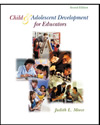 |  Child and Adolescent Development for Educators, 2/e Judith Meece,
University of North Carolina - Chapel Hill
Student Study Guide by Nancy Defrates-Densch
Language and Literacy Development
Learning ObjectivesAfter studying this chapter, you should be able to:
| Identify principles of language development and explain the rules that control all languages and dialects. |
 |  |  | | Use different theories of cognitive development to explain language development in children, and discuss the critical period theory of language acquisition. |
 |  |  | | Describe children's language development from infancy through adolescence, and explain how adults foster language development in children. |
 |  |  | | Explain how people who are bilingual or multilingual acquire several languages. |
 |  |  | | Explain the concept of emergent literacy and identify behaviors associated with emergent literacy. |
 |  |  | | Describe the development of children's ability to recognize print and understand its functions, and identify the print conventions children must learn to be literate. |
 |  |  | | Discuss what teachers can do to promote literacy development during early childhood. |
 |  |  | | Describe different components of the reading process; explain three different approaches to teaching reading; and identify how teachers can keep young people engaged in reading. |
 |  |  | | Describe the writing process, the development of writing skills, and what teachers can do to promote literacy development in the classroom. |
 |  |  | | Describe three different approaches to teaching linguistically diverse students; discuss how classroom interaction patterns can affect the learning of linguistically diverse students; and identify school- and classroom-level practices that enhance the learning of linguistically diverse students. |
|



 2002 McGraw-Hill Higher Education
2002 McGraw-Hill Higher Education